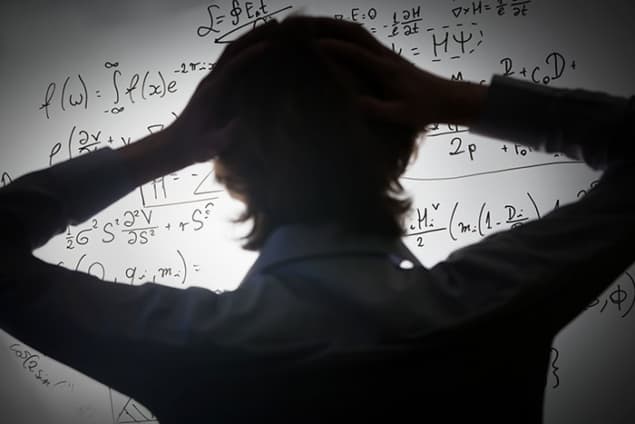
Including large numbers of mathematical equations in a research paper could impede the effective communication of the physics it describes. That is the controversial conclusion of a study of citation numbers by researchers from the University of Exeter in the UK, who advocate for the more accessible reporting of theoretical research. However, some physicists disagree with their analysis and conclusion.
Mathematics plays a fundamental role across the breadth of the sciences, underpinning the development of theoretical concepts. However, evolutionary biologists Tim Fawcett and Andrew Higginson noticed that many experimental biology papers seemed to lack a solid theoretical basis. They also found that theoretical biology papers were often neglected by the research community and that many evolutionary biologists confessed to being deterred by equation-dense papers.
These observations inspired the duo to look into how maths is presented in 649 papers from three major ecology and evolution journals. Using generalized linear models to analyse how often papers are cited, they found a negative correlation between a paper’s equation density and the number of citations it received. Indeed, there were 28% fewer citations on average for each additional equation per page.
Valuable papers may be ignored if they are not made accessible
Andrew Higginson, University of Exeter
No effect in physics
This result raised an important question: could this trend be fixed with improved mathematics training for biologists, or does it also exist in fields with a traditionally greater reliance on math, like physics? This was investigated in 2015 by the physicist Jonathan Kollmer of the Friedrich-Alexander University Erlangen, Germany, and colleagues. They found no evidence for the correlation in the citations of 1000 papers that appeared in Physical Review Letters (see “Are physicists afraid of mathematics?“). In that same study, Kollmer and colleagues also questioned the original analysis of biology citations by Fawcett and Higginson.
Now, Fawcett and Higginson have done their own analysis of Physical Review Letters papers and come to a different conclusion. They found an average 6–8% decrease in citation frequency for each additional equation per page. The duo suggest that this indicates that there are real and widespread barriers to the communication of mathematical work – independent from the levels of mathematical training, or any stigma about doing well in mathematics.
“Ideally, the impact of scientific work should be determined by its scientific value, rather than by the presentational style. Unfortunately, it seems valuable papers may be ignored if they are not made accessible,” says Higginson. “This presents a potentially enormous barrier to all kinds of scientific progress.”
Fawcett adds: “It takes time to scrutinise the details of a technical article – even for the most distinguished physics professors – so with many competing demands on their time, scientists may be choosing to skip over articles that take too much effort to digest.”
More explanatory text
But what might be done to address this communication issue? The researchers recommend both the use of more explanatory text to support equation-heavy theoretical papers, along with the relocation of non-essential equations – such as those describing the intermediate steps to solutions – to appendices where they will not affect the equation density of the main text.
This question can hardly be addressed by conducting purely correlative studies as they give no insight about any causal relationship
Jonathan Kollmer, Friedrich-Alexander University Erlangen
“Physicists need to think more carefully about how they present the mathematical details of their work, to explain the theory in a way that their colleagues can quickly understand,” says Fawcett.
“Anecdotally, I could well believe that the finding of a negative correlation between mathematical density and citations rates is real,” comments John Rayner – a physicist and science communication researcher at the Australian National University, who was not involved in this study. He adds: “If utility and clarity are the hallmarks of a high citation rate, then the circumspect use of mathematics can only help.”
Kollmer, however, remains unconvinced. “This question can hardly be addressed by conducting purely correlative studies as they give no insight about any causal relationship,” he says. Several reasons could account for such a correlation, he adds – such as the population differences between more theoretical and experimental research areas – and the correct explanation “cannot be evidenced by pure statistical analysis but would need sociological and more elaborated research”.
Fawcett and Higginson are now using the citation results to explore how the influence of theory spreads through scientific literature across different disciplines, along with investigating the root of mathematical anxiety, and the impact of promotion and funding criteria on the behaviour of scientists.
Fawcett and Higginson’s study is described in the New Journal of Physics and Kollmer and colleagues have since published a reply in the same journal.



